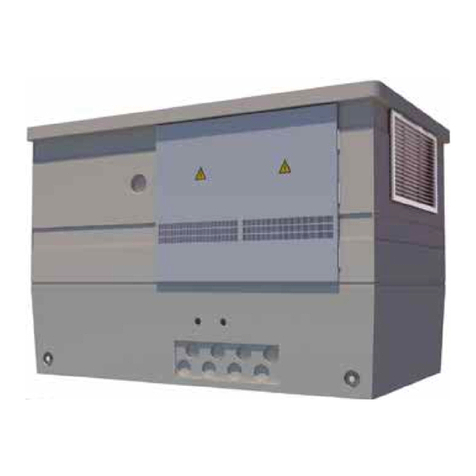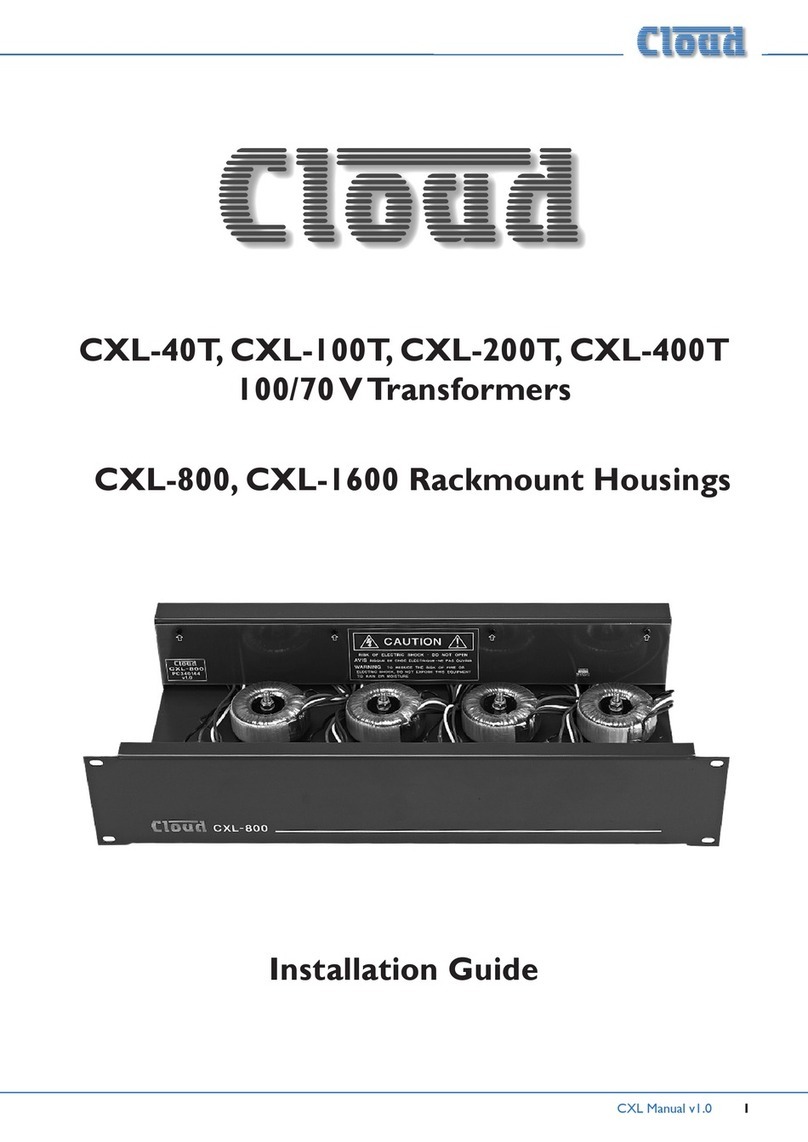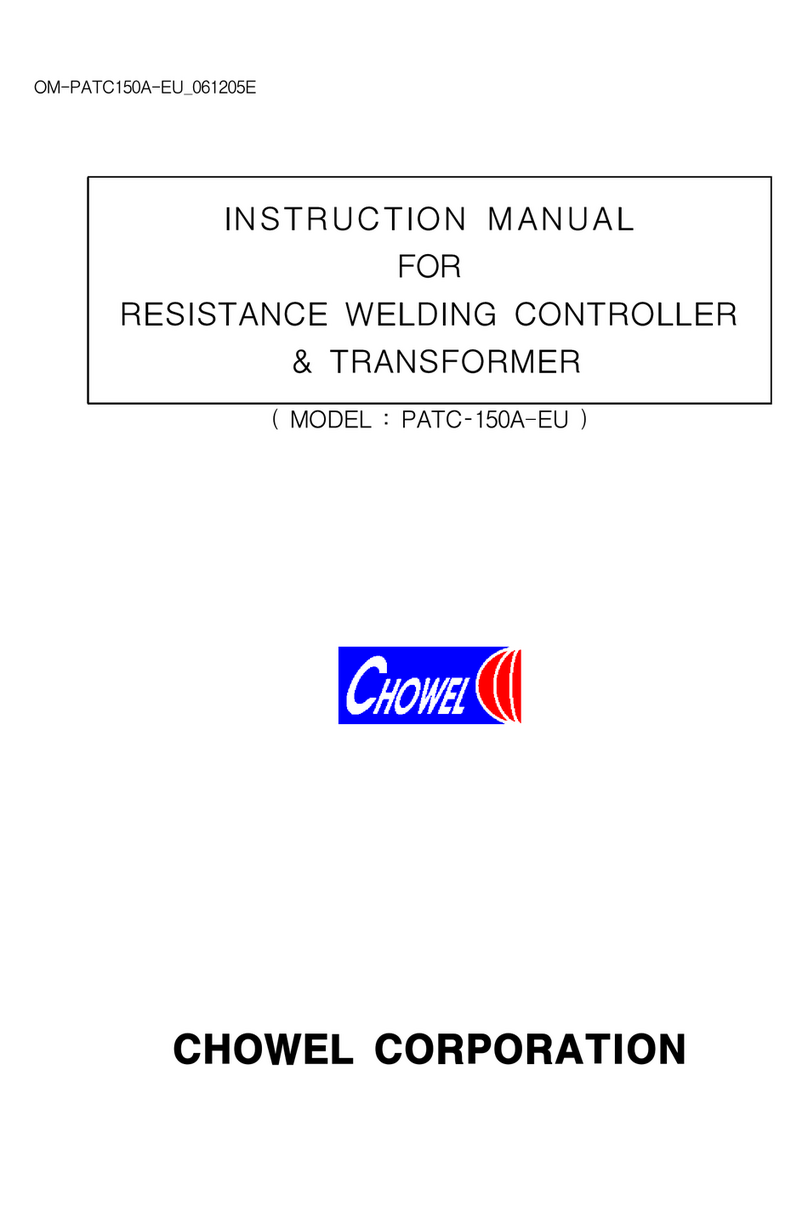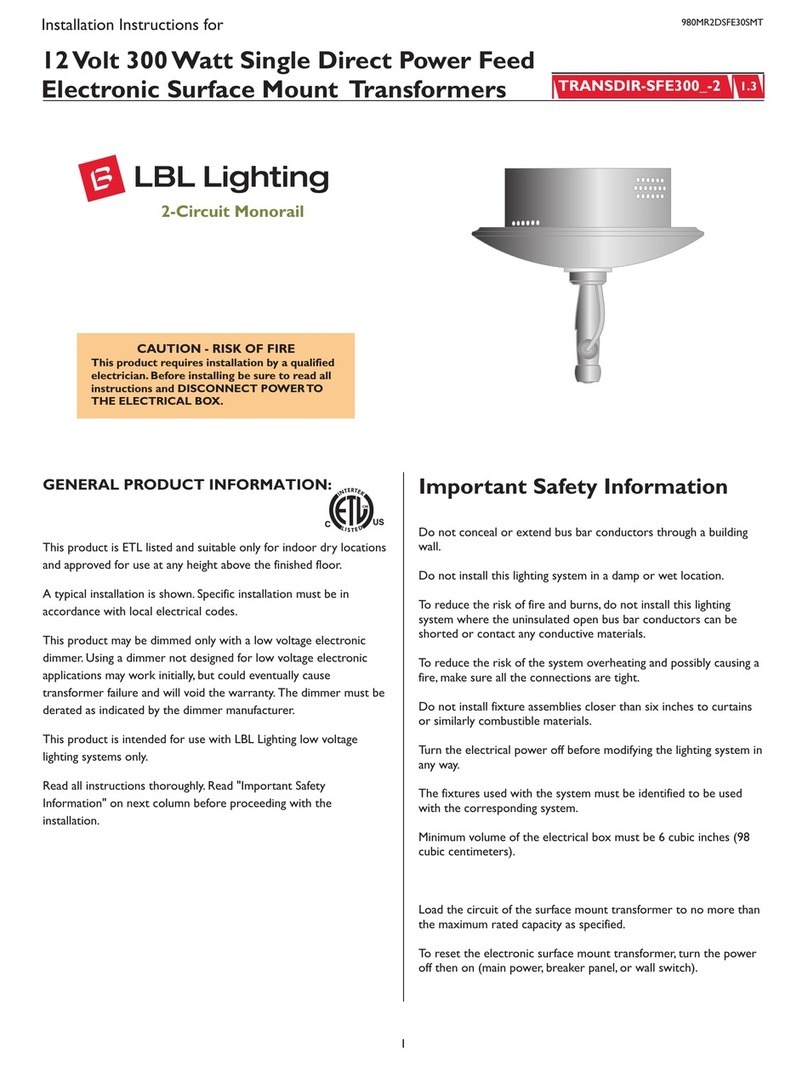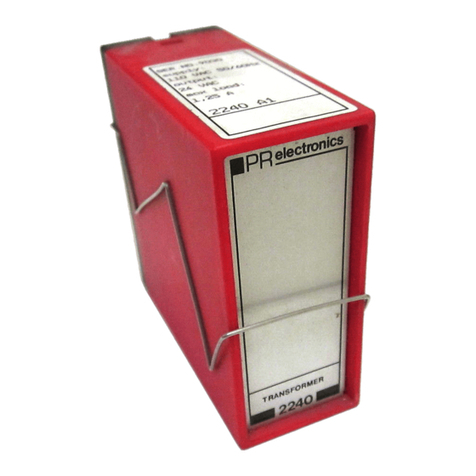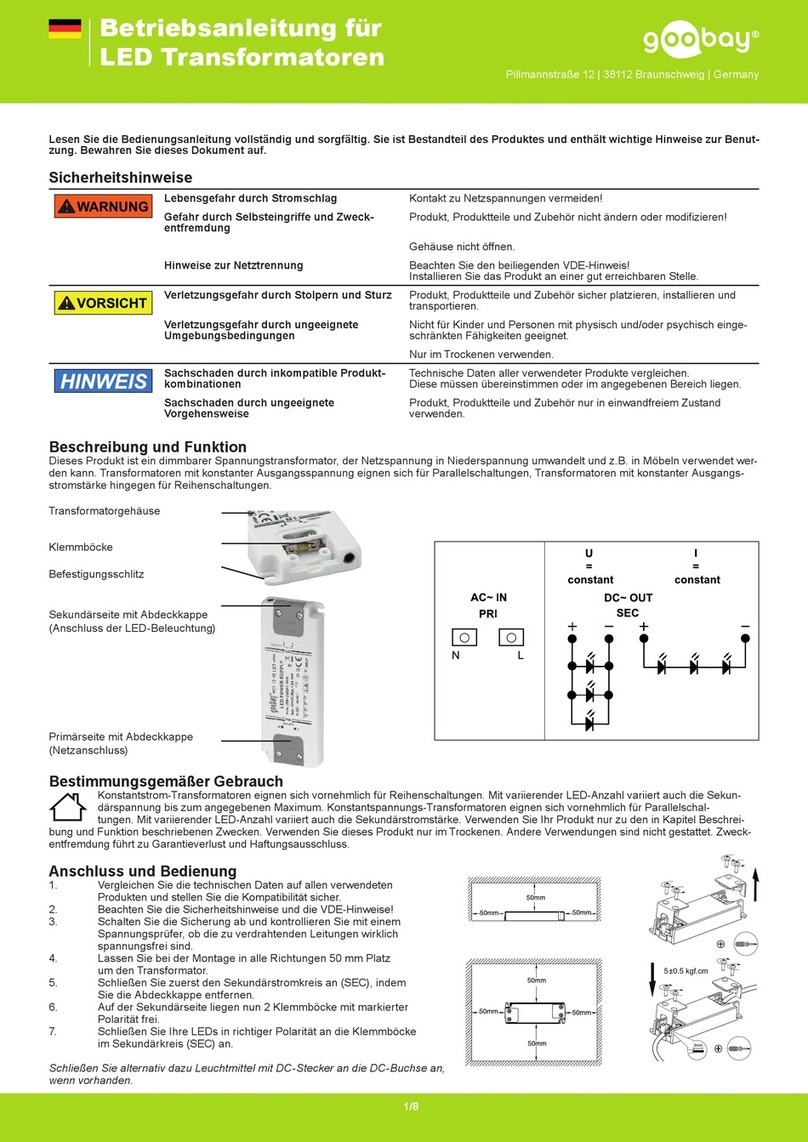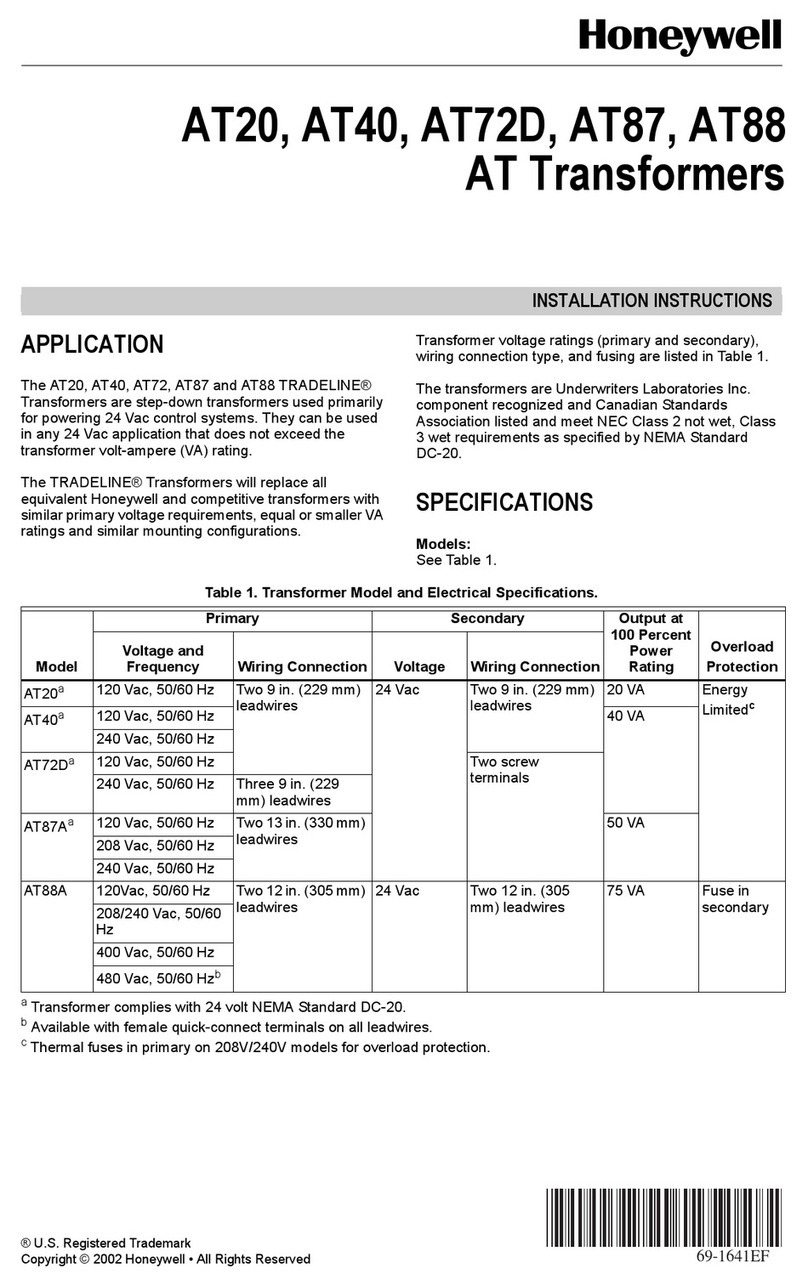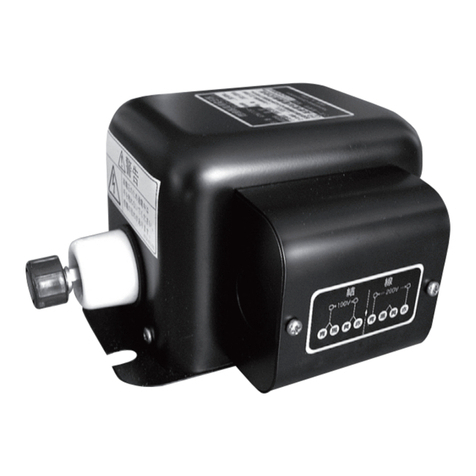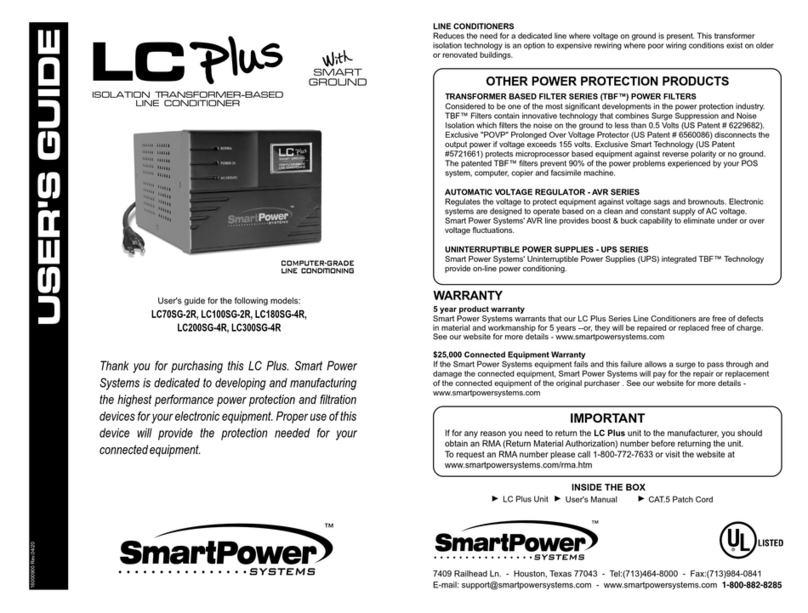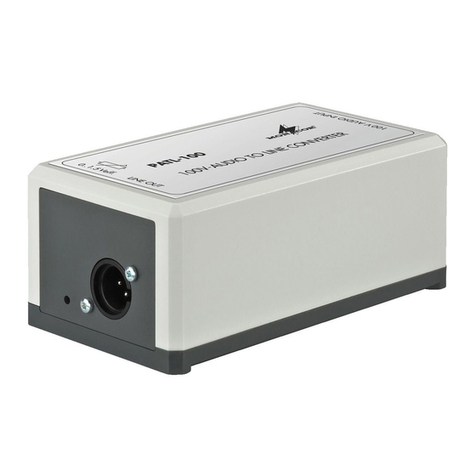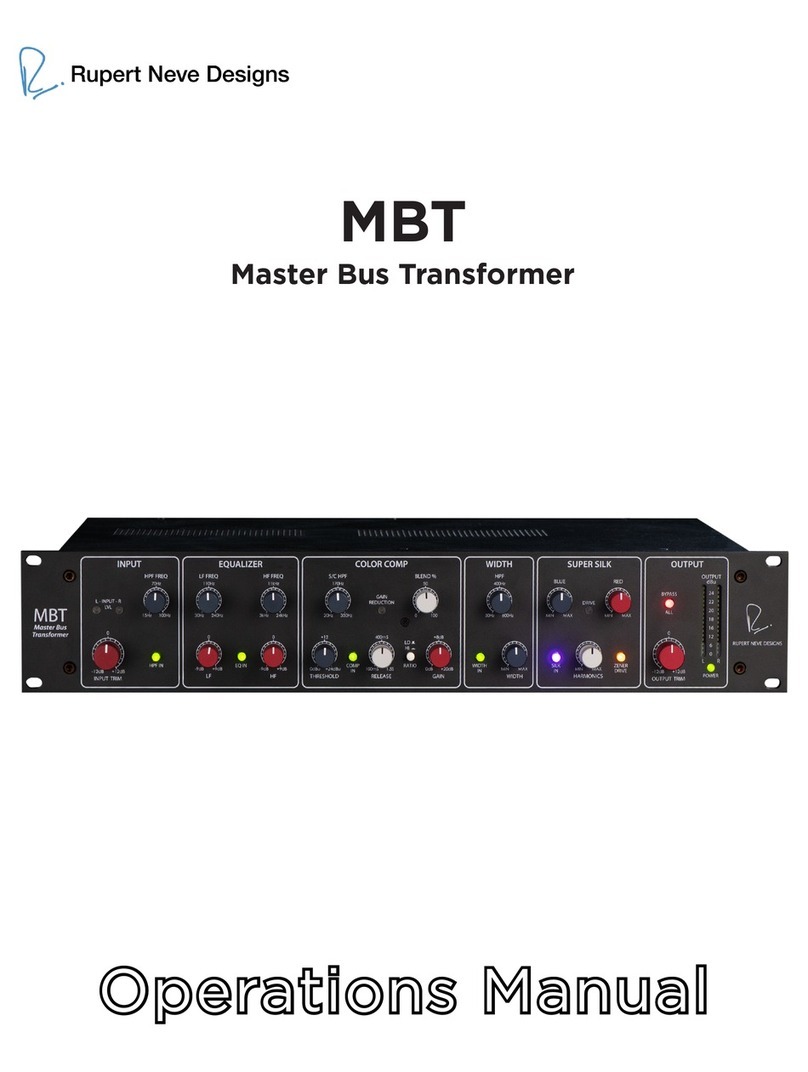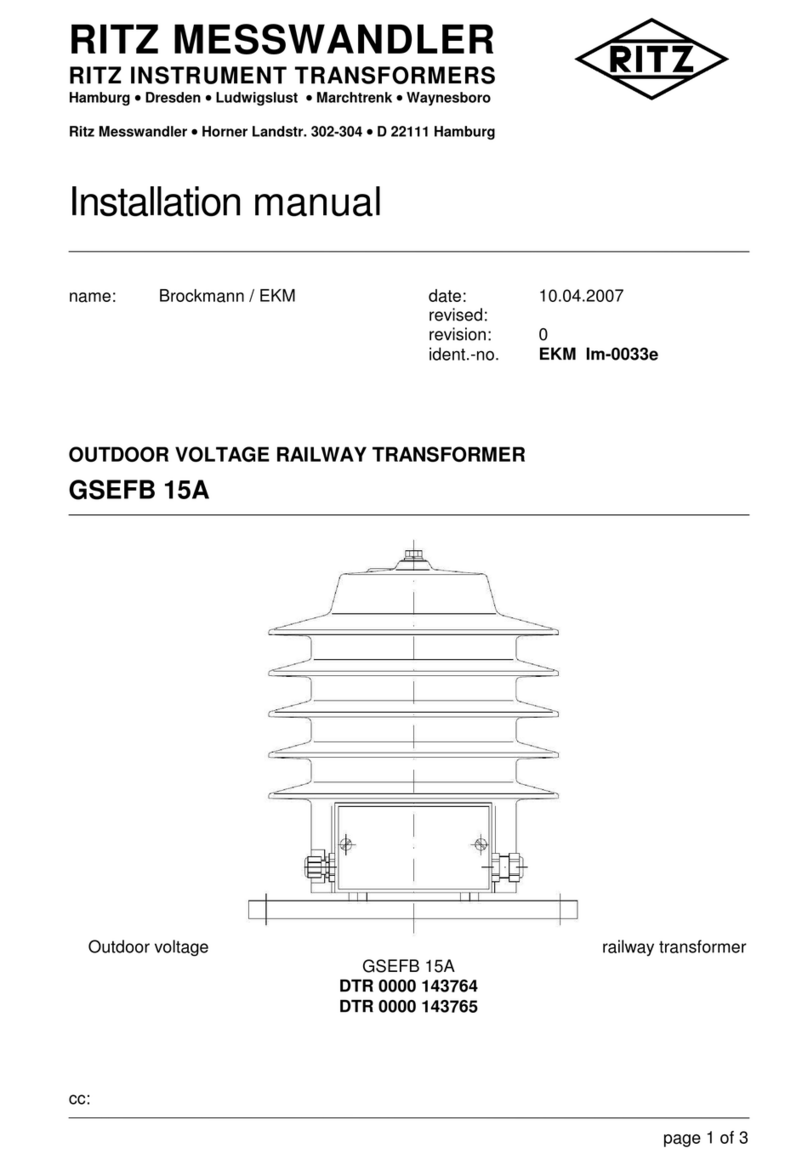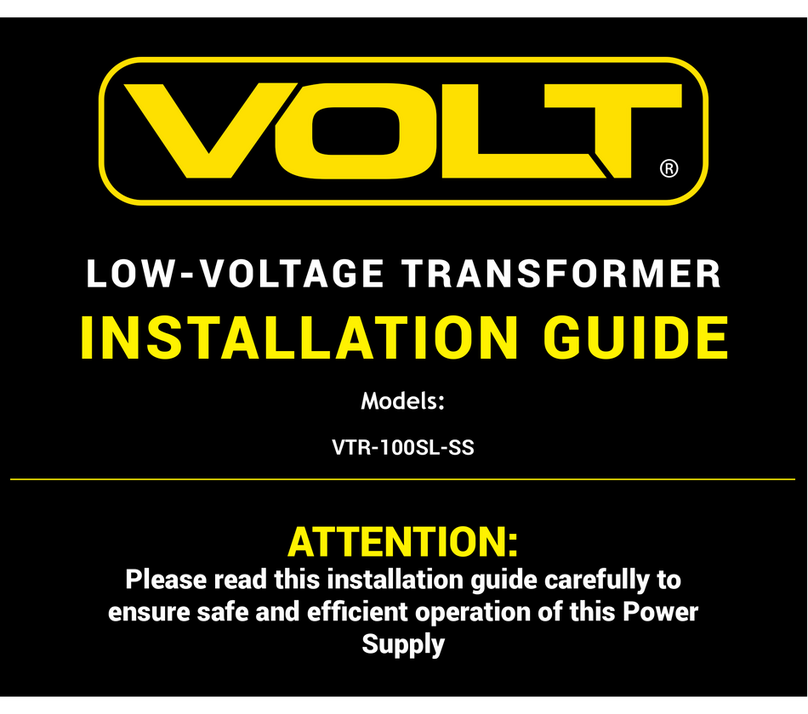Maddox MIT100-15A Instruction manual

VENTILATED DRY TYPE TRANSFORMERS
INSTALLATION, OPERATION&
MAINTENANCE MANUAL
1-800-270-2011-WWW.MADDOXTRANSFORMER.COM
1601SE COMMERCEAVE. BATTLE GROUND WA 98604
303GREERDR. SIMPSONVILLE SC 29681

INSTRUCTIONS
Ventilated Dry Type Transformers
SAFETY INFORMATION
IMPORTANT - READ CAREFULLY
WARNING - READ ALL INSTRUCTIONS CAREFULLY BEFORE
ATTEMPTING TO HANDLE, INSTALL, USE OR SERVICE THIS
EQUIPMENT. FAILURE TO FOLLOW INSTRUCTIONS COULD
RESULT IN SEVERE INJURY, DEATH, OR PROPERTY
DAMAGE.
CAUTION - THE EQUIPMENT COVERED BY THESE
INSTRUCTIONS SHOULD BE INSTALLED, OPERATED, AND
SERVICED ONLY BY COMPETENT TECHNICIANS FAMILIAR
WITH GOOD SAFETY PRACTICES. THESE INSTRUCTIONS
ARE WRITTEN FOR SUCH PERSONNEL AND ARE
NOT INTENDED AS A SUBSTITUTE FOR ADEQUATE
TRAINING AND EXPERIENCE IN SAFE PROCEDURES FOR
THIS TYPE OF EQUIPMENT.
THESE INSTRUCTIONS DO NOT PURPORT TO COVER
ALL DETAILS OR VARIATIONS IN EQUIPMENT NOR TO
PROVIDE FOR EVERY POSSIBLE CONTINGENCY TO BE
MET IN CONNECTION WITH INSTALLATION, OPERATION
OR MAINTENANCE. SHOULD FURTHER INFORMATION
BE DESIRED OR SHOULD PARTICULAR PROBLEMS
ARISE WHICH ARE NOT COVERED SUFFICIENTLY
FOR THE PURCHASER’S PURPOSES, THE MATTER
SHOULD BE REFERRED TO THE NEAREST SALES OFFICE
ALL APPLICABLE SAFETY PRACTICES INCLUDING, BUT NOT
LIMITED TO, OSHA, NFPA, ANSI, REGIONAL AND LOCAL
SAFETY CODES, SAFE WORKING PRACTICES AND GOOD
JUDGMENT, AS THEY MAY BE APPLIED TO THIS TYPE
OF EQUIPMENT MUST BE USED AND OBSERVED BY
ALL PERSONNEL WHEN INSTALLING, OPERATING AND
MAINTAINING THIS EQUIPMENT.
DANGER - HAZARD OF ELECTRICAL SHOCK OR BURN. DE-
ENERGIZE, LOCK OUT AND PROPERLY GROUND ALL
CIRCUITS SUPPLYING POWER TO THE TRANSFORMER AND
IT’S ACCESSORIES BEFORE REMOVING ANY CASE PANELS
OR COVERS AND WORKING INSIDE. FAILURE TO DE-
ENERGIZE THE TRANSFORMER AND IT’S ACCESSORIES
BEFORE REMOVING THE CASE PANELS OR COVERS COULD
RESULT IN SEVERE INJURY, DEATH, OR PROPERTY
DAMAGE.
DO NOT MAKE ANY CONNECTIONS THAT ARE
NOT AUTHORIZED BY THE NAMEPLATE OR
CONNECTION DIAGRAMS.
TRANSFORMER MUST BE PROPERLY GROUNDED BEFORE
ENERGIZING.
INTRODUCTION
This instruction manual details information about installing, operating, and maintaining ventilated dry type transformers. Each transformer has
its own specification and unique construction features. These features are detailed in the transformer outline and nameplate drawings.
This instruction bulletin is not an application guide for the ventilated dry type transformers or a substitute for adequate training in safe working
procedures for this and related electrical equipment. Installation of this electrical equipment may require special licenses or training. Consult
applicable national, industry, and local codes for specific requirements. The successful operation of any transformer depends on various
factors such as installation, loading, service conditions, and maintenance. Electrical systems in which transformers, along with vacuum or SF6
circuit breakers, are used are capable of high frequency over voltages which will not be suppressed by lightning arresters. These medium
voltage systems may require a detailed, high frequency over voltage system analysis and/or the addition of high frequency over voltage
protection. The transformer should be installed in conditions as specified in ANSI/IEEE Section C57.12.01 Usual Service Conditions, unless the
transformer is designed specifically for operation in conditions other than the usual service conditions.
- 1 -
6/2011
MIT100-15A
NOTE: If additional information is needed that thisinstruction manualdoes notcover,visit us on theweb awww.maddoxtransformer.com or
calltheCompany SalesOffice.
OF THE MADDOX INDUSTRIAL TRANSFORMER.

- 2 - 6/2011
RECEIVING
Upon receipt of the transformer, inspect as follows:
1. Review the shipping papers to ensure the shipment is complete.
List any noticeable damage on the receiving papers, file a
claim with the carrier at once, and notify the
nearest transformer representative.
2. Inspect the transformer for any obvious external damage that
may have occurred during shipment, including any evidence that
water or other contaminants have entered the transformer
during transit. The transformer should arrive from the factory
covered by a tarp. An internal inspection of the enclosure is not
usually required unless possible external damage has been
observed. If an internal inspection is required, carefully inspect
the leads, bolted mechanical and electrical joints, the core and
coils, and accessory equipment such as fans, controls, heater
strips, control power transformers, or current transformers.
3. Tighten any parts, which may have worked loose during
shipment.
4. Accumulated dirt or dust should be wiped off inside and outside
surfaces and any visible dirt or dust on the windings or in the air
ducts should be removed as explained under “Maintenance”.
5. Remove shipping braces from the unit. (Shipping braces will be
tagged to indicate they are for shipping only)
6. Do not leave the installation manual or any other foreign objects
inside transformer enclosure.
HANDLING
The transformer case and base are designed to allow the unit to be
moved by lifting, skidding, or jacking.
NOTE: In the event the transformer is supplied with Super Waffle
pads and/or springs and snubber plates please refer to our separate
instructions ESP-660 & ESP-661 respectively.
1. Lifting can be accomplished by the following means:
a) The preferable method for moving the complete transformer
assembly is by forklift truck under the base assembly.
b) To lift the entire transformer using jack pads, add properly
sized eye bolts to the jack pads and lift vertically using four
cables. Each cable angle with respect to the vertical must
not exceed 30°. If this limit cannot be met or if there is
danger of damaging the transformer during lifting, suitable
spreader bars should be used. Check to make sure no
cables are putting pressure on the transformer panels.
Note: If the transformer has an outdoor enclosure, then it is
advisable to remove the front and back panels to avoid eye
bolts hitting the louvers.
c) To lift the entire transformer from overhead, remove the top
cover and use the lifting eyes or lugs provided on the top of
the core and coil structure. Lift vertically using four cables.
Each cable angle with respect to the vertical must not
exceed 30°. If this limit cannot be met or if there is danger
of damaging the transformer during lifting, suitable spreader
bars should be used. Check to make sure no cables
are putting pressure on the termination bus.
d) To remove the core and coil assembly from the case,
remove the bolts holding the core and coil assembly to the
base assembly. Remove any other case panels or
partsthatwillpreventthecoreandcoilassembly
from being removed from the case. All high voltage
and low voltage line connections must be removed
and any accessory wiring disconnected. If a winding
temperature indicator or electronic temperature monitor
is present, the temperature sensing bulbs must be
removed from the tubular wells on the transformer
coils. Raise the core and coil assembly about 12
inches from the base. Use a forklift under the core and
coil assembly to move it out t hrough the front or rear
opening of the case. The unit can be moved in either
direction by using rollers under the base.
2. Pulling eyes are incorporated in the bolted on jacking pads for
use when skidding as well as when using rollers on horizontal
surfaces.
3. The unit can be jacked under the jacking pads located on the
front and back of the unit.
4. The transformer, complete with its enclosure, may be moved
without disturbing high voltage and low voltage equipment.
To do this, open the high voltage and low voltage bolted line
connections, remove all the bolts that attach the high voltage
and low voltage equipment enclosures to the transformer
enclosure, remove external ground connections to the
transformer ground pads, and remove any conduit
connections. With all these connections open it will be
possible to move the transformer in a direction at 90°
with respect to the long axis of the substation.
VIBRATION ISOLATION PADS
Rubber vibration isolation pads are an integral part of
the transformer and are placed between the core and coil
assembly and the transformer base to minimize vibration and
noise. The bolts used to secure the pads are over tightened at
the factory to reduce possibility of damage during shipping.
Before operating transformer, each bolt securing the vibration
pads should be loosened one full turn to reduce
transformer noise during operation.
NOTE: IN SEISMIC 4 LOCATIONS IT IS BEST TO KEEP THIS
BOLT FULLY TIGHTENED.
STORING
If storage becomes necessary, the transformer should be placed in
a clean, dry room in which a uniform temperature is
maintained. Air circulation through the transformer enclosure
should be permitted. The relative humidity to which the
insulating materials are exposed should be kept as low as
practical. The floor on which the transformer is stored should
be impervious to the upward migration of water vapor.
Precautions should be taken to guard against entrance of water
from any source such as roof leaks, broken water or steam
lines, windows, etc.
Electric resistance heaters should be used inside the enclosure in
cases where the relative humidity during storage is either high or
unknown. These heaters should be located under the windings on
both sides of the core. If heaters are used, air circulation through
the enclosure must be permitted. Generic furnace filters may be
mounted temporarily over the inlet and ventilation openings to
minimize dust accumulation within the enclosure. These
filters must be removed before the transformer is put in service.
Before placing the unit in service, check for dryness as
outlined under “Operation”.
MIT100-15A

- 3 - 6/2011
INSTALLATION
This transformer is to be installed in such a manner and location as to
minimize the hazards to all those who have access to it.
SURGE PROTECTION
The successful operation of any transformer depends on various
factors such as installation, loading, service conditions, and
maintenance. Electrical systems in which transformers, along with
vacuum or SF circuit breakers, are used are capable of high
frequency over voltages which will not be suppressed by lightning
arresters. These medium voltage systems may require a detailed,
high frequency over voltage system analysis and/or the addition of
high frequency over voltage protection. The transformer should be
installed in conditions as specified in ANSI/IEEE Section C57.12.01
Usual Service Conditions, unless the transformer is designed
specifically for operation in conditions other than the usual service
conditions.
INDOOR (CATEGORY C)
Follow all local and national codes when locating the transformer.
Make sure the ventilated openings, on the top and bottom of the
enclosure, are clear. The transformer must have proper clearances
from walls or other obstructions to allow circulation of air through and
around each unit (refer to nameplate for specific clearances).
For indoor installations, consult local and national codes to ensure all
applicable requirements are satisfied. If the transformer is located
near combustible materials, make sure the transformer meets or
exceeds the minimum clearances as required by the National
Electrical Code® (NEC) or other applicable local codes.
RESTRICTING ACCESS
Ventilated dry type transformers are not designed or constructed to
be tamperproof. Install the transformer in an area that is secure and
that only allows access to qualified personnel.
OUTDOOR (CATEGORY B)
For outdoor installations, consult local and national codes to ensure all
applicable requirements are satisfied. If the transformer is located
near combustible materials, make sure the transformer meets or
exceeds the minimum clearances as required by the NEC or other
applicable local codes. The transformer must have proper
clearances from walls or other obstructions to allow circulation of air
through and around each unit (refer to nameplate for specific
clearances). Ventilated outdoor substation transformers and pad-
mounted unit substations are designed for installation on a well-
drained, concrete pad. Unless specified otherwise, the transformer is
supplied without a bottom plate in the enclosure. If installing the
transformer in a elevated position where the bottom is exposed, add a
bottom plate (for rodent resistance) with provisions for drainage to
the enclosure. Proper drainage is mandatory.
ATMOSPHERIC CONDITIONS
Atmospheric conditions and accessibility are important
considerations when locating the transformer outdoors.
Install outdoor ventilated transformers in locations that are
free from unusual dust or chemical fumes. The enclosure helps
protect the transformer from atmospheric conditions such as dust,
rain, or snow. Also, the enclosure is designed to divert water from
energized parts, insulation, and wiring. However, it may not protect
against internal condensation or ice, or completely stop snow
from entering. If possible, locate the transformer in a shielded
area such as in the corner of a building or landscaped
windbreak to provide extra protection from driving wind, rain, or
snow. When subjected to severe weather, outdoor dry type
transformers should be inspected to determine if added protection is
necessary.
VENTILATION
For core and coil transformers, consult with factory for necessary
case dimensions to allow proper ventilation.
For adequate cooling the unit should be installed with proper
clearances from walls and other obstructions which might prevent
free circulation of air through and around the unit (refer
to nameplate for specific clearances). Mechanical clearances
should be taken into consideration in installing the transformer.
Sufficient room should be allowed for removal of panels for
cleaning and, with reverse arrangement of units, for changing of
taps.
If the transformer is to be installed in a vault, provide ventilation
adequate to keep the room temperature from exceeding that of the
incoming air by more than 5°C. The number and size of air outlets
required will depend on their distance above the transformer, and
on the efficiency and load cycle of the apparatus. See ANSI Guide
C57.94, “Guide for Installation and Maintenance of Dry-Type
Transformers”.
Arrange air inlets and outlets so that they are permanently open.
Do not use as ventilators, windows or doors which may be opened
and closed by attendants because of the danger of
excessive heating in case they are inadvertently left closed during
periods of heavy load or high temperature.If forced ventilation
is used, supply about 5000 cubic feet of air per minute (141
cubic meters per minute) for each 1000 kVA of transformer
capacity, and deliver the incoming air uniformly around the
transformer at floor level and low velocity.
MIT100-15A
Locatethetransformeron alevel foundation strong enough to
supporttheweight of the transformer,preferably of reinforced
concrete.MADDOX recommends thatyou do notplacethe
transformerdirectly on an earthen surface. Ensure thefoundation
hasadequatedrainage. Seismicregulations may require thatthe
transformerbe anchoredto the pador foundation.

- 4 - 6/2011
TORQUE CHART
The table below serves as a guide or suggestions for nominal torque
values for bolted electrical connections. Torque values may vary
based on individual joints, material and quantity of fasteners,
lubricated or not.
NOTES:
1. Always use two wrenches when tightening or loosening bolted
connections to prevent damage.
2. Tighten, wait several seconds, then re-tighten all connecting lugs
and bolts.
3. Torque values are in pounds.
CONNECTIONS
The transformer has both high voltage (HV) and low voltage (LV)
winding connections. Multiple tap positions are available on the HV
winding to allow for adjustments, which may be necessary
because of the specific supply voltage or transformer load
characteristics. If tap adjustments are necessary, see the
“CHANGING TAPS” section below. Connection points are clearly
labeled on the transformer. Refer to the nameplate and wiring
diagram to make the electrical connections. Never attempt to
make any connections that are not indicated on the
nameplate/connection diagram.
When making connections between plated aluminum transformer
terminals and copper or aluminum conductors of associated
equipment, the following procedure is recommended.
Assemble a spring washer and a flat washer under the head of
each bolt. Place the spring washer so that theconcave surface is
away from the bolt head and the periphery is on the flat washer.
The flat washer prevents the outer edges of the spring washer
from cutting through the plating and distributes the bolting
forces.
Place a flat washer under the nut on the opposite side of the joint
and tighten the nut until the spring washer is just flattened. (Washers
are flattened when there is a noticeable increase in bolting torque.)
After the nut has been properly tightened it should be locked
with a locking nut or such other locking device as may be
furnished with the equipment being connected to the transformer.
When clamp-type terminals are assembled on plated aluminum bars,
the same basic procedure given above should be followed except
that the spring washer and flat washer should be placed on the nut
on the eye-bolt and the bar.
When connecting bus bars, be sure the joints are properly aligned
prior to bolting to prevent excessive strain on the insulators. In
a terminal chamber, long sections of unsupported conductor should
be avoided and leads should be flexible enough to allow for
expansion and contraction.
For electrical connections, see “SURGE PROTECTION” on page 3.
GROUNDING
The core and coil structure is connected to the enclosure by
means of a flexible connector. This connection must be tight at all
times.
Grounding must be in accordance with NEC and all applicable
state and local codes. A NEMA Standard stainless steel ground
pad with two tapped holes is provided on the base assembly for
connecting the transformer enclosure to ground. A substantial
and thoroughly reliable connection should be made between
the pad and a low resistance ground through a conductor of
adequate cross section.
CHANGING TAPS
CAUTION: Failure to de-energize and grounding the
transformer before removing the panels to change taps
could result in serious personal injury or death.
NOTE: Do not bend tap terminals or position the hardware
in a manner that would reduce clearance between or cause
damage to tap terminals.
To change the tap position:
1. De-energize a n d p r o p e r l y g r o u n d the transformer
following the safety messages above and your company’s
lock-out/tag-out procedures.
2. Remove the enclosure panel or door to access the
transformer high voltage windings.
3. Use an appropriate grounding device to ground the coils
and discharge any static charge.
4. Locate the tap jumpers.
5. Change the tap jumpers on each phase to the appropriate
tap connection. The tap jumpers must be on the
same tap position for three phase transformers.
6. Torque the tap connections.
NOTE: For multiple voltages or other special
arrangements, see the transformer nameplate and/or
connection diagram.
7. Inspect the enclosure to ensure all hand tools, equipment, or
any other foreign materials are removed from the enclosure.
8. Re-install the door or enclosure panel.
Make no connections other than those authorized by the
nameplate.
ALUM SIL BRONZE STEELBOLT
SIZE
TYP TOL
+/- NOM IN FT IN FT IN FT
1/4-20 +/- 20% 50 4 60 5 75 6
5/16-18 +/- 20% 85 7 110 9 135 11
3/8-16 +/-20 % 145 12 195 16 240 20
1/2-13 +/-15 % 300 25 420 35 540 45
5/8-11 +/-15 % 480 40 840 70 1080 90
3/4-10 +/-15 % 720 60 1200 100 1560 130
MIT100-15A

- 5 - 6/2011
ALUMINUM TAP TERMINALS
Ventilated dry-type transformers that have aluminum windings are
equipped with aluminum tap terminals. Spring washers or spring
lock washers are included in the tap terminal hardware. When taps
are changed, the nuts should be tightened until these washers are
flattened. Washers are flattened when there is a noticeable
increase in bolting torque.
The terminals as received are free of oxides and taps may be
changed at installation without any special precautions. If at some
future time taps are changed, the following procedure is
recommended.
NOTE: Do not bend tap terminals or position the hardware in a
manner that would reduce clearance between or cause damage to
tap terminals.
1. Apply a light coat of silicone grease (General Electric G623 or
equivalent) to contact surfaces on terminals and links.
2. Scrub the contact areas with a wire brush, taking care not to
gouge the metal surfaces. This abrading will break up any
oxides that may have formed.
3. Wipe clean and reapply a thin film of silicone grease.
4. Bolt connecting link or jumper in the new position and tighten
the nut until the washer is flattened.
ENERGIZATION AND OPERATION
Only qualified personnel should perform the tests before energizing
the transformer and placing it in service. Disconnect ALL high voltage,
low voltage and neutral connections. Disconnect all auxiliary
equipment such as lightning arresters, the fan and temperature
control system, meters, or any other low voltage control system that is
connected to the windings that are involved in these tests. Please
disconnect CPT’s and short the secondary of CT’s if provided.
Before energizing a dry-type transformer either initially or after any
shutdown period in which the unit has cooled to ambient
temperature, the transformer should be inspected for evidence of
moisture and the insulation resistance should be checked. This
should be a one minute test taken with a 500 volt megohmmeter at
approximately 25 degrees C measured from winding to ground with
the windings not being tested connected to ground. An
insulation resistance in megohms equal to 200 times (rated
winding volts/1000) is a satisfactory value of resistance to permit
energizing the transformer. (Absorption of moisture can be
minimized during shutdown periods by using strip heaters to keep
the transformer temperature above ambient.)
DRYING
If moisture is found on the windings, leads, or insulation or if the
insulation resistance measurements are unsatisfactory, the
transformer should be dried. To dry, put a short circuit heat run on
the unit by short circuiting the low-voltage leads and impressing
impedance voltage on the high-voltage terminals. It may be
necessary to impress a voltage higher than the impedance voltage in
order to heat the windings sufficiently, but the total temperature of
the windings as determined by resistance should not exceed 190
C (or 185 C by non-mercury type thermometer placed in the
ducts between windings and in contact with them).
The heat run should be continued for a minimum of eight hours.
Insulation resistance is a function of insulation temperature as
well as moisture content, thus for comparison, readings must be
taken at the same temperature. During the course of a drying heat
run , the insulation resistance may initially decline as the insulation
heats up. After the insulation temperature stabilizes, the insulation
resistance will began to increase. When the insulation resistance
stabilizes, the drying procedure should be terminated. The
transformer should then be allowed to cool to ambient temperature
after which the insulation resistance should again be measured and
compared with minimum requirements.
An alternate to the short circuit drying heat run is to use a procedure
in which hot air is directed into the bottom of all windings.
The temperature of this air should not exceed 150° C but should
be as close to this temperature as possible to minimize the drying
time. If the transformer is equipped with fans, they should be
removed to prevent damage to the fan motors by exposure to this
hot air.
Oven drying is not recommended because an oven temperature
that would be effective in a reasonable length of time could
damage the tin plating on the current carryingterminal surfaces.
For further information on drying, refer to ANSI Guide C57.94,
“Guide for Installation and Maintenance of Dry-Type Transformers”.
FAN COOLING
NOTE: Fans are for temporary overloading only.
When fans are provided they are intended for use only when
the transformer is required to carry a load in excess of its self-
cooled rating. Fans should not be operated when the
transformer is carrying a load significantly less than its self-
cooled rating. Such operation may keep some parts of the
insulation system at a temperature low enough to permit
moisture absorption and may result in serious injury to the
insulation system.
MAINTENANCE
Refer to the “ENERGIZATION AND OPERATION” section.
The transformer should be inspected at periodic intervals
and corrective measures taken when necessary. The frequency at
which these inspections are made depends on operating conditions
and the importance of continuity of service. In clean, dry locations
an annual inspection may be adequate. In areas where the air is
contaminated with dust or chemical fumes, three-month intervals
may be required.
To inspect the transformer, de-energize, lockout and properly
ground all circuits supplying power to the transformer and
it’s accessories and remove the front and rear panels.
CAUTION: Failure to de-energize the transformer and it’s
accessories before removing the front and rear panels may
result in serious personal injury or death. Inspection should be
made for accumulation of dirt on insulating surfaces and in places
which would restrict the flow of air, for loose connections, for the
condition of terminal boards and for the general condition of the
transformer. Observation should also be made for signs of
overheating and of voltage creepage over insulating surfaces
as indicated by tracking or carbonizing.
MIT100-15A
If acceptance testis partof customerapprovalprocessthen
MADDOX recommends doing Applied potential or AC Hi-pottest@
75 %of theactualANSIlevels.

- 6 - 6/2011
Insulation resistance and power factor values may vary considerably
with transformer design, size and voltage. Thus changes in
these values versus time for a given transformer are more
significant than a specific value. It is suggested that these
measurements be made after cleaning the transformer at each
maintenance period. Care must be taken that these
measurements are made in the same way and with the
transformer at essentially the same temperature each time.
The voltage at which these measurements are made should not
exceed the line to ground operating voltage or 500 volts
whichever is greater. The transformer high voltage and low
voltage line connections must be opened for these tests. The
trends in these values will permit a more informed judgment as
to the condition of the insulation system. Refer to the paragraph
under “ENERGIZATION AND OPERATION” for minimum acceptable
values. Coil jack bolts, if provided, should be checked and tightened
if loose.
CLEANING
To inspect the transformer, de-energize, lockout and properly
ground all circuits supplying power to the transformer and it’s
accessories and remove the front and rear panels. CAUTION:
Failure to de-energize the transformer and it’s accessories
before removing the front and rear panels may result in serious
personal injury or death.
If dirt is found on the windings, insulators, leads or terminal
boards, it should be removed to permit free circulation of air and to
guard against the possibility of insulation breakdown. Particular
attention should be given to cleaning top and bottom ends of
winding assemblies and to ventilating ducts. The use of a vacuum
cleaner is recommended as the first step in cleaning followed by
the use of compressed air. The compressed air should be clean
and dry and should be applied at pressures below 25 PSI (170
kPa). Lead supports, terminal boards and other major insulating
surfaces should be brushed or wiped with a dry cloth. The use of
liquid cleaners is not recommended because of the possible
deteriorating effects on the insulating materials.
TERMS AND CONDITIONS
WHEN YOU NEED SERVICE
RENEWAL PARTS
MIT100-15A
Address orders for renewal parts to the nearest Sales Office of the
Maddox. Includeacomplete description of thepartwanted,
plusthe ratingand serialnumber of thetransformer.
If you need serviceon productsmanufactured by Maddox we are
ready to serveyou. ContactthenearestSales Office for more
information.
Please refer to yourcopy of the“TermsandConditions”for
warranty and productliability information.The “Termsand
Conditions”are available online at www.maddoxtransformer.com
Table of contents
